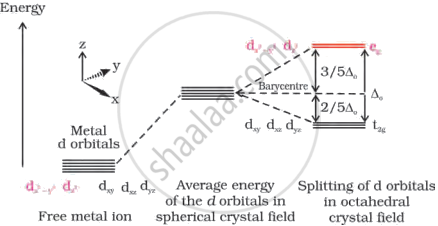Advertisements
Advertisements
प्रश्न
Draw figure to show the splitting of d orbitals in an octahedral crystal field.
उत्तर
Let the six ligands be symmetrically located along the Cartesian axes and the metal atom is at the origin.
On approaching the ligand, the energy of the d-orbitals increases as expected compared to the free ions. As is the case in a spherical crystal field.
The orbitals along the axes (`d_(Z^2)` and `d_(x^2 - y^2)`) repel more strongly than the dxy, dyz and dzx orbitals and have lobes directed between the axes. In the spherical crystal field, the `d_(Z^2)` and `d_(x^2 - y^2)` orbitals increase in energy and the dxy, dyz, dzx orbitals decrease in energy compared to the average energy.
Therefore, the degenerate set of d-orbitals splits into two groups – the low energy orbital group t2g and the high energy orbital group eg separated by energy Δ0.

d orbital splitting in an octahedral crystal field
APPEARS IN
संबंधित प्रश्न
The hexaquo manganese (II) ion contains five unpaired electrons, while the hexacyanoion contains only one unpaired electron. Explain using Crystal Field Theory.
What is spectrochemical series? Explain the difference between a weak field ligand and a strong field ligand.
How does the magnitude of Δ0 decide the actual configuration of d orbitals in a coordination entity?
How are the following conversions carried out?
Benzoic acid into metanitrobenzoic acid.
An aqueous pink solution of cobalt (II) chloride changes to deep blue on addition of excess of HCl. This is because:
(i) \[\ce{[Co(H2O)6]^{2+}}\] is transformed into \[\ce{[CoCl6]}^{4-}\]
(ii) \[\ce{[Co(H2O)6]^{2+}}\] is transformed into \[\ce{[CoCl4]}^{2-}\]
(iii) tetrahedral complexes have smaller crystal field splitting than octahedral complexes.
(iv) tetrahedral complexes have larger crystal field splitting than octahedral complex.
Give the electronic configuration of the following complexes on the basis of Crystal Field Splitting theory.
\[\ce{[CoF6]^{3-}, [Fe(CN)6]^{4-} and [Cu(NH3)6]^{2+}}\].
Arrange following complex ions in increasing order of crystal field splitting energy (∆O):
\[\ce{[Cr(Cl)6]^{3-}, [Cr(CN)6]^{3-}, [Cr(NH3)6]^{3+}}\].
The CFSE for octahedral [CoCl6]−4 is 18,000 cm−1. What will be the CFSE for tetrahedral [CoCl3]−2?
[Ni(H2O)6]2+ (aq) is green in colour whereas [Ni(H2O)4 (en)]2+ (aq)is blue in colour, give reason in support of your answer.
In a coordination entity, the electronic configuration of the central metal ion is t2g3 eg1
Draw the crystal field splitting diagram for the above complex.
Considering crystal field theory, strong-field ligands such as CN–:
The magnitude of CFSE depends upon ______
The CFSE of [CoCl6]3– is 18000 cm–1 the CFSE for [CoCl4]– will be ______.
What is the difference between a weak field ligand and a strong field ligand?
For octahedral Mn(II) and tetrahedral Ni(II) complexes, consider the following statements:
(i) Both the complexes can be high spin.
(ii) Ni(II) complex can very rarely below spin.
(iii) With strong field Ligands, Mn(II) complexes can be low spin.
(iv) Aqueous solution of Mn (II) ions is yellow in colour.
The correct statements are:
On the basis of crystal field theory, write the electronic configuration for d4 with a strong field ligand for which Δ0 > P.
Read the passage carefully and answer the questions that follow.
|
Crystal field splitting by various ligands Metal complexes show different colours due to d-d transitions. The complex absorbs light of specific wavelength to promote the electron from t2g to eg level. The colour of the complex is due to the transmitted light, which is complementary of the colour absorbed. The wave number of light absorbed by different complexes of Cr ion are given below:
|
Answer the following questions:
(a) Out of ligands "A", "B", "C" and "D", which ligand causes maximum crystal field splitting? Why?
OR
Which of the two, “A” or “D” will be a weak field ligand? Why?
(b) Which of the complexes will be violet in colour? [CrA6]3- or [CrB6]3+ and why?
(Given: If 560 - 570 nm of light is absorbed, the colour of the complex observed is violet.)
(c) If the ligands attached to Cr3+ ion in the complexes given in the table above are water, cyanide ion, chloride ion, and ammonia (not in this order).
Identify the ligand, write the formula and IUPAC name of the following:
- [CrA6]3-
- [CrC6]3+
Explain the difference between a weak field ligand and a strong field ligand.
